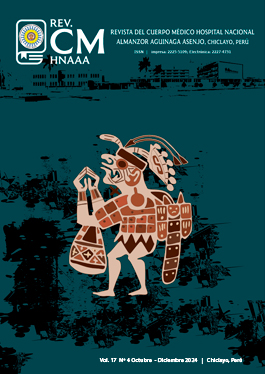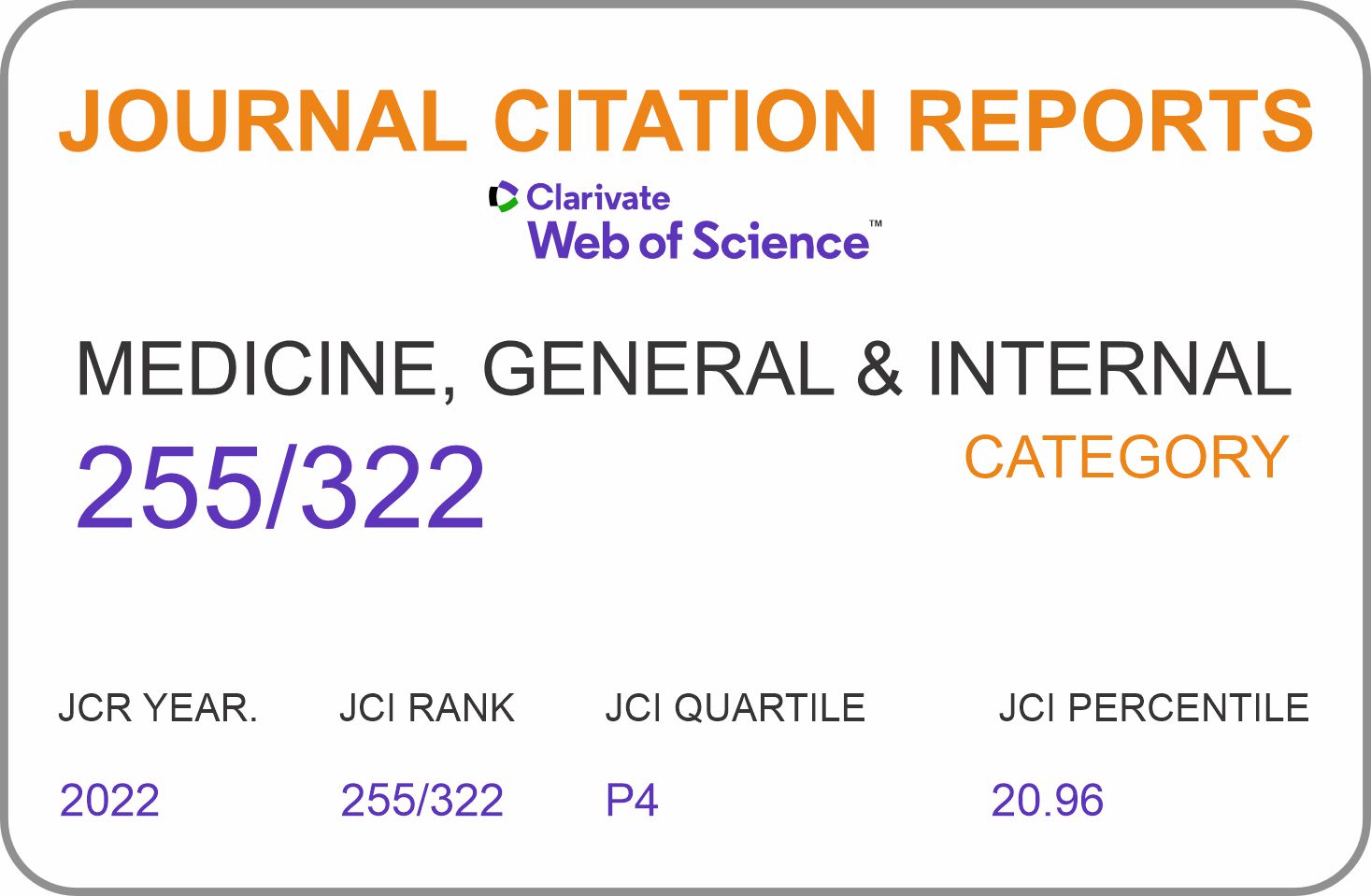Albumin as a prognostic factor in the survival of patients with diffuse large B-cell lymphoma treated at a hospital in Lima, Peru
DOI:
https://doi.org/10.35434/rcmhnaaa.2024.174.2225Keywords:
Diffuse Large B-Cell Lymphoma, Prognosis, Albumin, Survival, BiomarkersAbstract
Introduction: Diffuse large B-cell lymphoma (DLBCL) is the most prevalent form of non-Hodgkin lymphoma in adults, with a high mortality rate. Low serum albumin can be a biological indicator of the disease reflected as increased inflammation or increased toxicities. Currently, the International Prognostic Index (IPI) is the accepted model for prognosis in patients with DLBCL. Objective: To determine the prognostic value of albumin in overall survival (OS) of patients with DLBCL treated with immunochemotherapy in a hospital in Peru during the period 2017-2019. Materials and methods: Analytical, cross-sectional, retrospective and observational study. It consisted of 161 patients with DLBCL diagnosed and treated during the mentioned period. The SPSS v27 program was used for statistical analysis. Hazard ratios (HR) and 95% confidence intervals (CI) were used to assess the prognostic impact of albumin on overall survival (OS). Results: The OS of patients up to 12 months was 94%, 3 years was 87%, and 5 years was 87%. In multivariate Cox proportional hazards regression analysis, albumin (p=0.037; HR=3.614 95% CI [1.079 – 12.105]) and IPI (p=0.017; HR 1.891 95% CI [1.121 – 3.19]) were found to be the independent variables influencing OS in patients with DLBCL. Conclusions: Hypoalbuminemia might be a risk factor for shorter OS. In association with the IPI, a cumulative prognostic scoring system could be developed in patients with DLBCL.
Downloads
Metrics
References
Camicia R, Winkler HC, Hassa PO. Novel drug targets for personalized precision medicine in relapsed/refractory diffuse large B-cell lymphoma: a comprehensive review. Mol Cancer. 2015;14:207. doi:10.1186/s12943-015-0474-2
Villela L, Torre-Viera M, Idrobo-Quintero H, Beltran BE, Grupo de Estudio de Linfoproliferativos de Latinoamérica (GELL). Non-Hodgkin lymphoma treatment in middle-income countries in Latin America: perspective of the Latin American Study Group of Lymphoproliferative Disorders [Grupo de Estudio de Linfoproliferativos de Latino América (GELL)]. Hematol Amst Neth. 2022;27(1):1208–16. doi:10.1080/16078454.2022.2141960
Cevallos J, Montalvo N. New horizons and future directions in the theranostics of diffuse lymphoma of large B cells. Metro ciencia [Internet].2017; 25(2):32-35. [citado el 16 de julio de 2023]. Disponible en: https://docs.bvsalud.org/biblioref/2019/03/986637/metro-junio-out-2017-1-30-33.pdf
Beltran B, Morales D, Quiñones P, Salas R, Carrasco-Yalan AA. Distribution and Pathology Characteristics of Non Hodgkin Lymphoma in Peru: A Study of 1014 Cases Using WHO Classification of Lymphoid Neoplasm. Blood [Internet]. 2007 [citado el 16 de julio de 2023];110(11):4419. doi:10.1182/blood.V110.11.4419.4419
La Agencia Internacional de Investigación en Cáncer (IARC) incluyó al Perú en “Globocan 2018”Instituto Nacional de Enfermedades Neoplásicas [Internet]. [citado el 16 de julio de 2023]. Disponible en: https://portal.inen.sld.pe/la-agencia-internacional-de-investigacion-en-cancer-incluyo-al-peru-en-globocan-2018/
International Non-Hodgkin’s Lymphoma Prognostic Factors Project. A predictive model for aggressive non-Hodgkin’s lymphoma. N Engl J Med. 1993;329(14):987–94. doi:10.1056/NEJM199309303291402
Sehn LH, Berry B, Chhanabhai M, Fitzgerald C, Gill K, Hoskins P, et al. The revised International Prognostic Index (R-IPI) is a better predictor of outcome than the standard IPI for patients with diffuse large B-cell lymphoma treated with R-CHOP. Blood. 2007;109(5):1857–61. doi:10.1182/blood-2006-08-038257
Ziepert M, Hasenclever D, Kuhnt E, Glass B, Schmitz N, Pfreundschuh M, et al. Standard International prognostic index remains a valid predictor of outcome for patients with aggressive CD20+ B-cell lymphoma in the rituximab era. J Clin Oncol Off J Am Soc Clin Oncol. 2010;28(14):2373–80. doi:10.1200/JCO.2009.26.2493
Zhou Z, Sehn LH, Rademaker AW, Gordon LI, LaCasce AS, Crosby-Thompson A, et al. An enhanced International Prognostic Index (NCCN-IPI) for patients with diffuse large B-cell lymphoma treated in the rituximab era. Blood [Internet]. 2014 [citado el 16 de julio de 2023];123(6):837–42. doi:10.1182/blood-2013-09-524108
El-Galaly TC, Villa D, Alzahrani M, Hansen JW, Sehn LH, Wilson D, et al. Outcome prediction by extranodal involvement, IPI, R-IPI, and NCCN-IPI in the PET/CT and rituximab era: A Danish-Canadian study of 443 patients with diffuse-large B-cell lymphoma. Am J Hematol. 2015;90(11):1041–6. doi:10.1002/ajh.24169
Ruppert AS, Dixon JG, Salles G, Wall A, Cunningham D, Poeschel V, et al. International prognostic indices in diffuse large B-cell lymphoma: a comparison of IPI, R-IPI, and NCCN-IPI. Blood. 2020;135(23):2041–8. doi:10.1182/blood.2019002729
Montalbán C, Díaz-López A, Dlouhy I, Rovira J, Lopez-Guillermo A, Alonso S, et al. Validation of the NCCN-IPI for diffuse large B-cell lymphoma (DLBCL): the addition of β2 -microglobulin yields a more accurate GELTAMO-IPI. Br J Haematol. 2017;176(6):918–28. doi:10.1111/bjh.14489
Chen Y, Neelapu S, Feng L, Bi W, Yang T-H, Wang M, et al. Prognostic significance of baseline peripheral absolute neutrophil, monocyte and serum β2-microglobulin level in patients with diffuse large b-cell lymphoma: a new prognostic model. Br J Haematol. 2016;175(2):290–9. doi:10.1111/bjh.14237
Kanemasa Y, Shimoyama T, Sasaki Y, Tamura M, Sawada T, Omuro Y, et al. Beta-2 microglobulin as a significant prognostic factor and a new risk model for patients with diffuse large B-cell lymphoma. Hematol Oncol. 2017;35(4):440–6. doi:10.1002/hon.2312
Bairey O, Shacham-Abulafia A, Shpilberg O, Gurion R. Serum albumin level at diagnosis of diffuse large B-cell lymphoma: an important simple prognostic factor. Hematol Oncol. 2016;34(4):184–92. doi:10.1002/hon.2233
Melchardt T, Troppan K, Weiss L, Hufnagl C, Neureiter D, Tränkenschuh W, et al. A modified scoring of the NCCN-IPI is more accurate in the elderly and is improved by albumin and β2 -microglobulin. Br J Haematol. 2015;168(2):239–45. doi:10.1111/bjh.13116
Bari A, Marcheselli L, Sacchi S, Marcheselli R, Pozzi S, Ferri P, et al. Prognostic models for diffuse large B-cell lymphoma in the rituximab era: a never-ending story. Ann Oncol Off J Eur Soc Med Oncol. 2010;21(7):1486–91. doi:10.1093/annonc/mdp531
Bento L, Díaz-López A, Barranco G, Martín-Moreno AM, Baile M, Martín A, et al. New prognosis score including absolute lymphocyte/monocyte ratio, red blood cell distribution width and beta-2 microglobulin in patients with diffuse large B-cell lymphoma treated with R-CHOP: Spanish Lymphoma Group Experience (GELTAMO). Br J Haematol. 2020;188(6):888–97. doi:10.1111/bjh.16263
Han Y, Yang J, Liu P, He X, Zhang C, Zhou S, et al. Prognostic Nomogram for Overall Survival in Patients with Diffuse Large B-Cell Lymphoma. The Oncologist. 2019;24(11):e1251–61. doi:10.1634/theoncologist.2018-0361
Beltrán BE, Villela L, Torres MA, Otero V, Fiad L, Peña C, et al. A Multi-Institutional Validation of the Prognostic Value of the Neutrophil-to-Lymphocyte Ratio in Patients With Diffuse Large B-Cell Lymphoma: A Study From The Latin American Group of Lymphoproliferative Disorders (GELL). Clin Lymphoma Myeloma Leuk. 2020;20(10):637–46. doi:10.1016/j.clml.2020.04.016
Beltran BE, Ramos W, De La Cruz-Vargas JA. Índice linfocito/monocito como factor pronóstico en linfoma células grandes B difuso en un hospital nacional de Lima-Perú, período 2010-2017. Rev Fac Med Humana [Internet]. 2019 [citado el 16 de julio de 2023];19(2):40–7. doi:10.25176/RFMH.v19.n2.2068
Ministerio de Salud del Perú. Análisis de la situación del Cáncer en el Perú, 2018 [Internet]. 2020 [citado el 17 de julio de 2023]. Disponible en: http://bvs.minsa.gob.pe/local/MINSA/5158.pdf
Hill LA, Bodnar TS, Weinberg J, Hammond GL. Corticosteroid-binding globulin is a biomarker of inflammation onset and severity in female rats. J Endocrinol. 2016;230(2):215–25. doi:10.1530/JOE-16-0047
Ngo L, Hee S-W, Lim L-C, Tao M, Quek R, Yap S-P, et al. Prognostic factors in patients with diffuse large B cell lymphoma: Before and after the introduction of rituximab. Leuk Lymphoma. 2008;49(3):462–9. doi:10.1080/10428190701809156
Mackintosh JF, Cowan RA, Jones M, Harris M, Deakin DP, Crowther D. Prognostic factors in stage I and II high and intermediate grade non-Hodgkin’s lymphoma. Eur J Cancer Clin Oncol. 1988;24(10):1617–22. doi:10.1016/0277-5379(88)90054-5
Lin T-L, Kuo M-C, Shih L-Y, Dunn P, Wang P-N, Wu J-H, et al. The impact of age, Charlson comorbidity index, and performance status on treatment of elderly patients with diffuse large B cell lymphoma. Ann Hematol. 2012;91(9):1383–91. doi:10.1007/s00277-012-1463-9
Prakash G, Sharma A, Raina V, Kumar L, Sharma MC, Mohanti BK. B cell non-Hodgkin’s lymphoma: experience from a tertiary care cancer center. Ann Hematol. 2012;91(10):1603–11. doi:10.1007/s00277-012-1491-5
Coiffier B, Lepage E. Prognostic factors in large-cell lymphomas. Leuk Lymphoma. 1993;10 Suppl:57–60. doi:10.3109/10428199309149113
Steward WP, Todd ID, Harris M, Jones JM, Blackledge G, Wagstaff J, et al. A multivariate analysis of factors affecting survival in patients with high-grade histology non-Hodgkin’s lymphoma. Eur J Cancer Clin Oncol. 1984;20(7):881–9. doi:10.1016/0277-5379(84)90159-7
Khera R, Jain S, Kumar L, Thulkar S, Vijayraghwan M, Dawar R. Diffuse large B-cell lymphoma: experience from a tertiary care center in North India. Med Oncol Northwood Lond Engl. 2010;27(2):310–8. doi:10.1007/s12032-009-9211-2
Kharfan-Dabaja MA, Chavez JC, Yu D, Zhu W, Fernandez-Vertiz EI, Perkins J, et al. Severe hypoalbuminemia at day 90 predicts worse nonrelapse mortality and overall survival after allogeneic hematopoietic stem cell transplantation for acute myelogenous leukemia and myelodysplastic syndrome. Biol Blood Marrow Transplant J Am Soc Blood Marrow Transplant. 2011;17(3):384–93. doi:10.1016/j.bbmt.2010.07.011
Komrokji RS, Corrales-Yepez M, Kharfan-Dabaja MA, Al Ali NH, Padron E, Rollison DE, et al. Hypoalbuminemia is an independent prognostic factor for overall survival in myelodysplastic syndromes. Am J Hematol. 2012;87(11):1006–9. doi:10.1002/ajh.23303
Chihara D, Oki Y, Ine S, Yamamoto K, Kato H, Taji H, et al. Analysis of prognostic factors in peripheral T-cell lymphoma: prognostic value of serum albumin and mediastinal lymphadenopathy. Leuk Lymphoma. 2009;50(12):1999–2004. doi:10.3109/10428190903318311
Watanabe T, Kinoshita T, Itoh K, Yoshimura K, Ogura M, Kagami Y, et al. Pretreatment total serum protein is a significant prognostic factor for the outcome of patients with peripheral T/natural killer-cell lymphomas. Leuk Lymphoma. 2010;51(5):813–21. doi:10.3109/10428191003721359
Zhu Y-J, Huang J-J, Xia Y, Zhao W, Jiang W-Q, Lin T-Y, et al. Primary mediastinal large B-cell lymphoma (PMLBCL) in Chinese patients: clinical characteristics and prognostic factors. Int J Hematol. 2011;94(2):178–84. doi:10.1007/s12185-011-0898-4
Hasenclever D, Diehl V. A prognostic score for advanced Hodgkin’s disease. International Prognostic Factors Project on Advanced Hodgkin’s Disease. N Engl J Med. 1998;339(21):1506–14. doi:10.1056/NEJM199811193392104
Arcaini L, Lazzarino M, Colombo N, Burcheri S, Boveri E, Paulli M, et al. Splenic marginal zone lymphoma: a prognostic model for clinical use. Blood. 2006;107(12):4643–9. doi:10.1182/blood-2005-11-4659
Gupta D, Lis CG. Pretreatment serum albumin as a predictor of cancer survival: a systematic review of the epidemiological literature. Nutr J. 2010;9:69. doi:10.1186/1475-2891-9-69
Hennig B, Honchel R, Goldblum SE, McClain CJ. Tumor necrosis factor-mediated hypoalbuminemia in rabbits. J Nutr. 1988;118(12):1586–90. doi:10.1093/jn/118.12.1586
Brenner DA, Buck M, Feitelberg SP, Chojkier M. Tumor necrosis factor-alpha inhibits albumin gene expression in a murine model of cachexia. J Clin Invest. 1990;85(1):248–55. doi:10.1172/JCI114419
McMillan DC, Watson WS, O’Gorman P, Preston T, Scott HR, McArdle CS. Albumin concentrations are primarily determined by the body cell mass and the systemic inflammatory response in cancer patients with weight loss. Nutr Cancer. 2001;39(2):210–3. doi:10.1207/S15327914nc392_8
Ballmer PE, Ochsenbein AF, Schütz-Hofmann S. Transcapillary escape rate of albumin positively correlates with plasma albumin concentration in acute but not in chronic inflammatory disease. Metabolism. 1994;43(6):697–705. doi:10.1016/0026-0495(94)90117-1
Aviles A, Yañez J, López T, García EL, Guzmán R, Díaz-Maqueo JC. Malnutrition as an adverse prognostic factor in patients with diffuse large cell lymphoma [Internet]. Arch Med Res. 1995 [Cited 2024 Agost 12];26(1):31–4. Available from: https://pubmed.ncbi.nlm.nih.gov/7711444/
Downloads
Published
How to Cite
License
Copyright (c) 2024 Luis Gustavo Morales-Cuzquén , José Manuel Vela-Ruiz, Diana I. Ferrer-Ponce, Cesar Fernandez-Anccas , Luis Roldán-Arbieto, Brady Ernesto Beltrán-Garate , Luis Villela, Jhony A. De La Cruz-Vargas

This work is licensed under a Creative Commons Attribution 4.0 International License.















